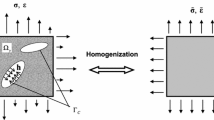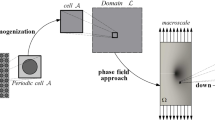Abstract
Deterministic nonlocal damage models permit avoiding spurious mesh sensitivity and predict ‘structure’ size effect which is in accordance with experimental observations on notched specimens made of concrete. However, these deterministic models are unable to predict ‘volume’ size effect exhibited by unnotched specimens in direct tension because the effect of heterogeneity has been introduced via a deterministic strain-softening behaviour.
The main idea of our model is to consider two scales: the meso-scale (the representative volume) of size l r and the micro-scale, of size d (d ⩽ l r). The plane is subdivided in square cells of size d. Each cell is supposed to be homogeneous and behaves in a purely brittle manner. The heterogeneity of the material properties are introduced by attributing to each cell a random threshold value picked according to a power law distribution function of parameter m. The breaking criterion is nonlocal.
In finite element calculations, each cell is discretized in finite element meshes which have the same threshold value. Each finite element mesh behaves in a purely brittle manner and its breaking criterion is the ratio of the volume average of the elastic energy over a cube of size l r and the threshold value.
Numerical simulations on notched and unnotched specimens will show that the proposed model yields mesh insensitive calculations and predicts both ‘volume’ and ‘structure’ size effects which are qualitatively in accordance with experimental observations.
Similar content being viewed by others
References
A. Carpinteri, Engineering Fracture Mechanics 16 (1982) 467–481.
X.Z. Hu and F.H. Wittman, in Proceeding of International Conference on the Recent Developments in Fracture of Concrete and Rock, Cardiff, UK (1989) 307–316.
A. Maji and S.P. Shah, Experimental Mechanics (1988) 27–33.
J.R. Rice, Journal of Applied Mechanics 35 (1968) 379–386.
J. Du, A.S. Kobayashi and N.M. Hawkins, Journal of Engineering Mechanics ASCE 115 (10) (1989) 2136–2149.
V. Kadlecek and Z. Spetla, Effect of size and shape of test specimens on the direct tensile strength of concrete, Bulletin de la RILEM 36 (1967) 175–184.
R. L'Hermite, Influence de la dimension absolue sur la résistance à la flexion, Annales de l'I.T.B.T.P. 309–310 (1973) 39–41.
R.J. Torrent, A general relation between tensile strength and specimen geometry for concrete-like materials, Materials and Structures, Bulletin de la RILEM 58 (1977) 187–196.
W. Weibull, Journal of Applied Mechanics 18, no 3 (1951) 287–293.
Z.P. Bazant, Applied Mechanics Review 5 (1985) 675–705.
M. Kachanov, Foundations of Plasticity, North-Holland Publishers (1976).
J. Lemaitre and J.L. Chaboche, Mécanique des Matériaux Solides, Dunod-Bordas (ed.) (1985).
Z.P. Bazant and T. Belytschko, Wave propagation in a strain softening bar, Journal of Engineering Mechanics ASCE 111 (1985) 381–389.
H.B. Mühlhaus, Application of Cosserat theory in numerical solutions of limit load, Ing. Arch. 59 (1989) 124–137.
Z.P. Bazant, T. Belytschko and T.P. Chang, Continuum theory for strain softening, Journal of Engineering Mechanics ASCE 110 (1984) 1666–1692.
D. Lasry and T. Belytschko, Localization limiters in transient problems, International Journal of Solids 24 (1988) 581–597.
G. Pijaudier-Cabot and Z.P. Bazant, Journal of Engineering Mechanics ASCE 113 (1987) 1512–1533.
Z.P. Bazant and G. Pijaudier-Cabot, in Proceeding of the 4th International Conference on Numerical Methods in Fracture Mechanics, A.R. Luxmoore et al. (eds) (1987) 411–432.
Z.P. Bazant and G. Pijaudier-Cabot, Journal of Engineering Mechanics ASCE 115 (1989) 755–767.
J. Mazars, G. Pijaudier-Cabot and C. Saouridis, Size effect and continuous damage in cementitious materials, International Journal of Fracture 51 (1991) 159–173.
H.J. Hermann, A. Hansen and S. Roux, Fracture of disordered elastic lattices in two dimensions, Physical Review 637 (1989).
P. Rossi and J.M. Piau, in Cracking and Damage, J. Mazars and Z.P. Bazant (eds.). Elsevier Publishers (1989) 91–103.
D. Breysse, Journal of Engineering Mechanics ASCE 116 (1990) 1489–1510.
A. Hansen, E.L. Hinrichsen and S. Roux, Scale-invariant disorder in fracture and related breakdown phenomena, Physical Review B 43 (1991) 665.
I. Laalai, Effets d'échelle dans les matériaux quasi-fragiles à microstructure aléatoire: Approches locale et non-locale, thesis E.N.P.C Paris (1993).
H.D. Bui and A. Ehrlacher, Propagation of damage in elastic and plastic solids, in Advances in Fracture Research, D. François et al. (eds.). Pergamon Press 2 (1981) 533–552.
B. Fedelich, Trajets d'équilibre des systèmes mécaniques dissipatifs à comportement indépendant du temps physique, thesis ENPC Paris (1990).
Q.S. Nguyen, Bifurcation et stabilité des systèmes irréversibles obéissant au principe de dissipation maximale, Journal de Mécanique Théorique et Appliquée vol. 3 no 1 (1984) 41–61.
K. Sab and I. Laalai, Une approche unifiée des effets d'échelle dans les matériaux quasi fragiles, Comptes Rendus à l'Académie des Sciences 316 série II (1993) 1187–1192.
I. Laalai and K. Sab, Size effect in quasi-brittle materials: a new micromechanics model, in Mecamat 93, International Seminar of Materials, Collection de la D.E.R. d'E.D.F., Eyrolles (ed.)., Paris (1993) 188–198.
I. Laalai and K. Sab, Size effect and stochastic nonlocal damage in quasi-brittle material, in Probabilities and Materials, Serie E, Applied Sciences, Vol. 269. D. Breysse (ed.). Paris (1993) 151–161.
Author information
Authors and Affiliations
Rights and permissions
About this article
Cite this article
Laalai, I., Sab, K. A stochastic nonlocal damage model. Int J Fract 76, 121–140 (1996). https://doi.org/10.1007/BF00018533
Received:
Accepted:
Published:
Issue Date:
DOI: https://doi.org/10.1007/BF00018533




